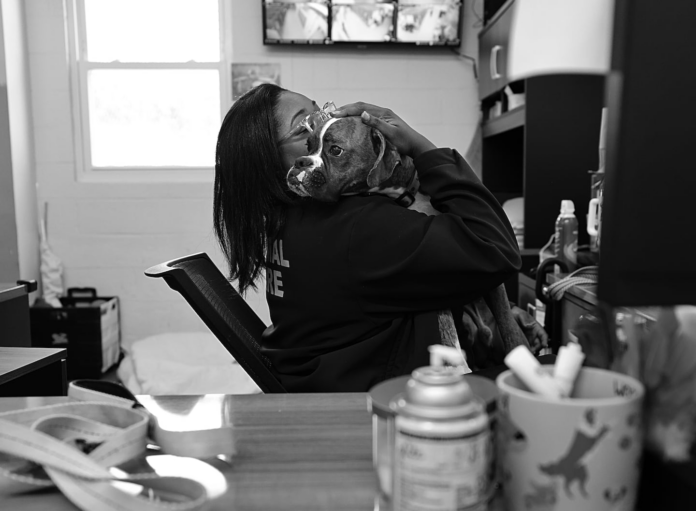Housed in an old eyeglass factory in Roslindale, the public shelter cares for all of the city’s surrendered, abandoned, or rescued animals.
“This is a real tough part of the job,” Bonds said with a laugh.
Robyn Bonds held Bruce on her lap, talking to him gently as if the brown and white boxer were a child. The longtime head clerk at the Boston Animal Care and Control Shelter is also known to tuck Chihuahuas into her jacket to give them extra love.
The conditions aren’t ideal. The building is small, with peeling paint, and a faulty air conditioner.
“What we lack in resources, we make up for in resiliency,” said Alexis Trzcinski, the shelter’s director since 2020.
Unlike private shelters, such as the MSPCA-Angell Boston and the Animal Rescue League of Boston, the city’s shelter takes “anything and everything” that comes through its doors, including animals from owners who were evicted, incarcerated, or experienced a medical emergency.
As part of its mission, the shelter provides a food pantry, free preventative veterinary care for homeless pet owners, affordable adoptions, along with other services, such as rabies clinics, according to Trzcinski and the shelter’s website.
Advertisement
“We are the quiet responders,” she said.
Vet tech student Luna Escos played with one of the kittens at the Animal Care and Control Shelter. Suzanne Kreiter/Globe Staff
At a time of rising costs and surging pet abandonment post pandemic, public animal shelters play a critical role in veterinary medicine, one expert said.
“It’s unreal how much the price of [medical] consumables went up,” said Laurence Sawyer, an assistant teaching professor at Tufts University’s Cummings School of Veterinary Medicine. “To be able to have access to those services is just so important, again, for the health of the pet as well as the owners.”
Care for the city’s most vulnerable creatures is in high demand. At times, the Roslindale shelter has housed as many as 25 animals, despite only having enough space for 15, Trzcinski said.
“We do the hard work, but there’s only so much we can do in these walls we are contained within,” she said. ”The best way to inspire people to care about animals is to make them feel connected to the places that support animals.”
Advertisement
The shelter building, set up against commuter rail tracks, has little room to expand. When the shelter moved to its location in 2001, it was meant to be temporary, Trzcinski said.
But it’s still here, caring for dogs like Bruce, the shy boxer often bothered by the constant cacophony of barking dogs, despite sound panels. With no overflow space for animals, which occasionally include a reptile or chicken, some must be sent to shelters in other communities, she said.
Dr. Martha Smith-Blackmore performed a neuter on a kitten at the Animal Care and Control Shelter. Suzanne Kreiter/Globe Staff
A decade ago, the shelter’s operations came under scrutiny after the Animal Rescue League of Boston identified management and overcrowding issues at the facility. Then-Mayor Martin J. Walsh ordered its evacuation. It later reopened with improved management and operations.
Now, despite cramped quarters, the Animal Rescue League of Boston has “no problems” with the shelter, according to Erin Doyle, senior vice president of animal welfare and veterinary services at the league.
“They have a lot on their plate as the shelter that is run by the city, and so they have a lot of pressures on them,” Doyle said. “They do a lovely job of focusing on the welfare, the wellbeing of the animals in their care, and also trying to recognize their facilities are a limiting factor.”
Trzcinski said she envisions a shelter that is more accessible to the community, along with space for animals to be separated by species.
“This is the public’s shelter and [residents] should be able to access the animals,” she said. “We want this to be a destination.”
The city plans to spend just over $1.3 million next spring to improve the shelter, which runs under the city’s Parks and Recreation Department. The plan calls for a new paint job, an upgrade to the heating and ventilation system, and a new emergency generator, according to the city.
Advertisement
Surrendered dogs waited for a chance at adoption at the Animal Care and Control Shelter. Suzanne Kreiter/Globe Staff
Regardless of its shortcomings, the facility remains a safe haven for Boston’s nearly forgotten pets.
Kayata Gomes, an animal room attendant, gave Bergeron, a “confiscated” Australian shepherd mix, a food maze, a bowl to enhance “enrichment,” she said.
“They’re all my favorite,” Gomes said, rattling off her own “pet names” she gives each animal in her charge.
There’s Luna or “Big Mama,” a brown and tan American bully, and a fluffy dog she calls “my hairy friend.”
Bonds, still holding the boxer, Bruce, on her lap, said he was a “a bit nervous” and “a little skinny.”
But, his demeanor “is a big improvement” from when he first arrived.
Cats are held separately downstairs. Love, a black Domestic Shorthair, is affectionately called “an escape artist.” On a piece of paper outside of Love’s crate, the words “Clip Doors! Escapes!” was written in large letters and circled multiple times.
One of the animal room attendants quipped that the cat always has “mission impossible playing in her head.”
“These animals are real true heroes,” Trzcinski said, as Love chased after bright orange and blue toys.
Animal care attendant Olivia Smith played with a kitten in an enclosure at the Animal Care and Control Shelter. Suzanne Kreiter/Globe Staff
Ava Berger can be reached at ava.berger@globe.com. Follow her @Ava_Berger_.




